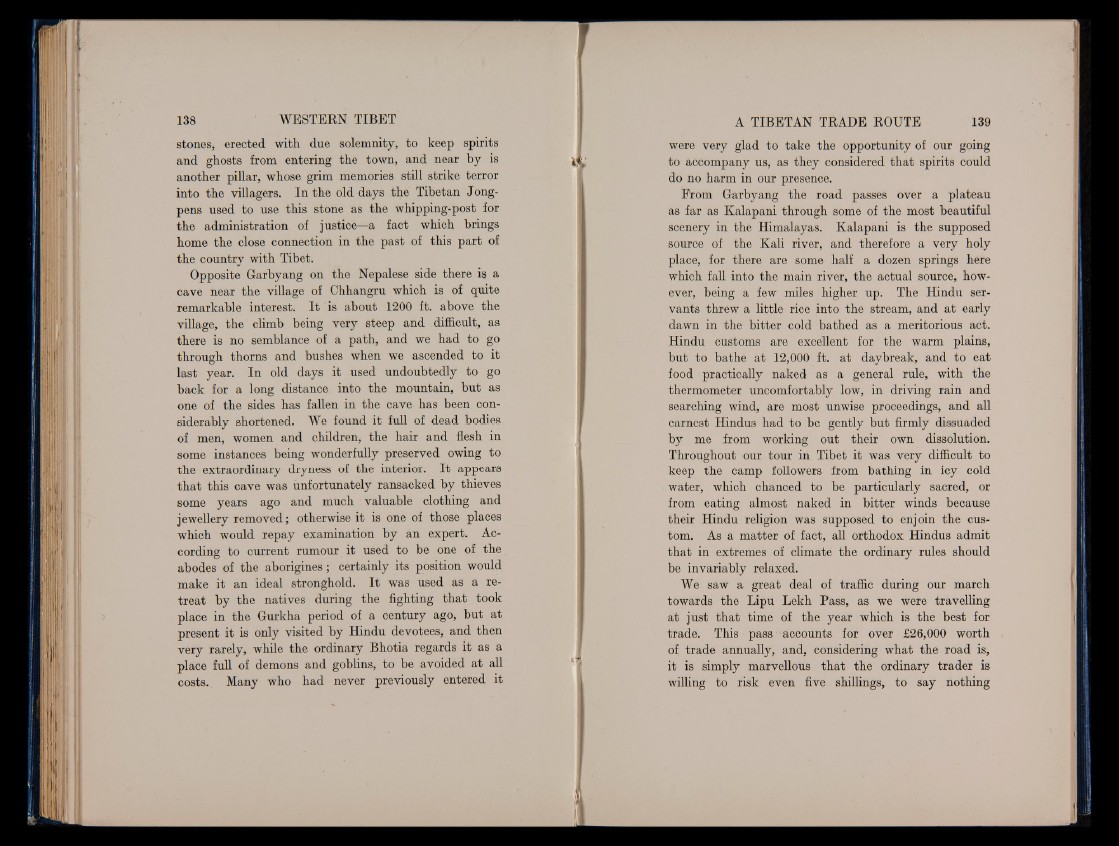
stones, erected with due solemnity, to keep spirits
and ghosts from entering the town, and near by is
another pillar, whose grim memories still strike terror
into the villagers. In the old days the Tibetan Jong-
pens used to use this stone as the whipping-post for
the administration of justice—a fact which brings
home the close connection in the past of this part of
the country with Tibet.
Opposite Garbyang on the Nepalese side there is a
cave near the village of Chhangru which is of quite
remarkable interest. It is about 1200 ft. above the
village, the climb being very steep and difficult, as
there is no semblance of a path, and we had to go
through thorns and bushes when we ascended to it
last year. In old days it used undoubtedly to go
back for a long distance into the mountain, but as
one of the sides has fallen in the cave has been considerably
shortened. We found it full of dead bodies
of men, women and children, the hair and flesh in
some instances being wonderfully preserved owing to
the extraordinary dryness of the interior. I t appears
that this cave was unfortunately ransacked by thieves
some years ago and much valuable clothing and
jewellery removed; otherwise it is one of those places
which would repay examination by an expert. According
to current rumour it used to be one of the
abodes of the aborigines; certainly its position would
make it an ideal stronghold. I t was used as a retreat
by the natives during the fighting that took
place in the Gurkha period of a century ago, but at
present it is only visited by Hindu devotees, and then
very rarely, while the ordinary Bhotia regards it as a
place full of demons and goblins, to be avoided at all
costs. Many who had never previously entered it
were very glad to take the opportunity of our going
to accompany us, as they considered that spirits could
do no harm in our presence.
From Garbyang the road passes over a plateau
as far as Kalapani through some of the most beautiful
scenery in the Himalayas. Kalapani is the supposed
source of the Kali river, and therefore a very holy
place, for there are some half a dozen springs here
which fall into the main river, the actual source, however,
being a few miles higher up. The Hindu servants
threw a little rice into the stream, and at early
dawn in the bitter cold bathed as a meritorious act.
Hindu customs are excellent for the warm plains,
but to bathe at 12,000 ft. at daybreak, and to eat
food practically naked as a general rule, with the
thermometer uncomfortably low, in driving rain and
searching wind, are most unwise proceedings, and all
earnest Hindus had to be gently but firmly dissuaded
by me from working out their own dissolution.
Throughout our tour in Tibet it was very difficult to
keep the camp followers from bathing in icy cold
water, which chanced to be particularly sacred, or
from eating almost naked in bitter winds because
their Hindu religion was supposed to enjoin the custom.
As a matter of fact, all orthodox Hindus admit
that in extremes of climate the ordinary rules should
be invariably relaxed.
We saw a great deal of traffic during our march
towards the Lipu Lekh Pass, as we were travelling
at just that time of the year which is the best for
trade. This pass accounts for over £26,000 worth
of trade annually, and, considering what the road is,
it is simply marvellous that the ordinary trader is
willing to risk even five shillings, to say nothing